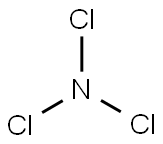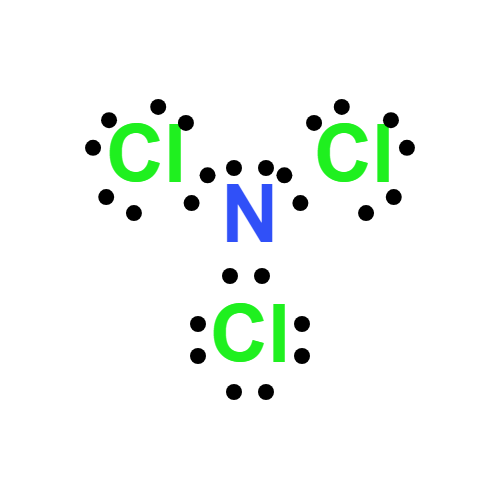Chemical Properties
Yellow oil or rhombic crystals.Insoluble in cold
water; decomposes in hot water; soluble in chloroform, phosphorus trichloride, and carbon disulfide.
Physical properties
Yellow, oily, heavy liquid; pungent odor; density 1.653 g/mL; freezes to rhombohedral crystalline solid below -40°C; evaporates in air rapidly; vaporpressure 150 torr at 20°C; explodes when heated at 93°C; highly unstable, decomposes explosively in light; insoluble in water, decomposes slowly in cold water after several hours; decomposes in hot water; soluble in benzene, chloroform, carbon tetrachloride, carbon disulfide and phosphorus trichloride.
Uses
Bleaching of flour; wastage control of citrus fruit.
Preparation
Nitrogen trichloride is prepared by passing chlorine gas into slightly acid solution of ammonium chloride. The product is continuously extracted with carbon tetrachloride:
NH
4Cl + 3Cl
2 → NCl
3 + 4HCl
Hypochlorous acid, HOCl, also may be used instead of chlorine in such preparation.
Nitrogen trichloride can be prepared by the action of anhydrous chlorine with anhydrous ammonia:
3Cl
2 + NH
3 → NCl
3 + 3HCl
Nitrogen trichloride is made commercially by electrolyzing an acidified solution of ammonium chloride.
Definition
ChEBI: Nitrogen trichloride is a nitrogen halide.
Hazard
Explodes when heated to approximately
200F (93C) or when exposed to direct sunlight.
Toxic by ingestion and inhalation, strong irritant.
Safety Profile
Moderately toxic by
inhalation. An irritant to the eyes, skin,
mucous membranes, and a systemic central
nervous system irritant. An explosive
sensitive to impact, light, and ultrasound.
The solid explodes on melting. The liquid
explodes above 60°C. Concentrated
solutions are also explosive. Explosive
decomposition is initiated by contact with:
concentrated ammonia, arsenic, dinitrogen
tetraoxide, hydrogen sulfide, hydrogen
trisulfide, nitrogen oxide, organic matter,
ozone, phosphine, phosphorus, potassium
cyanide, potassium hydroxide solutions,
selenium, hydrogen chloride, hydrogen
fluoride, hydrogen bromide, hydrogen
iodide. mxtures with chlorine + hydrogen
are potentially explosive. Upon
decomposition it emits toxic fumes of Cl-
and NOx. See also CHLORIDES.


